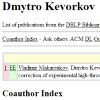| |
 
Hans-Jürgen Bandelt and
Andreas W. M. Dress. A canonical decomposition theory for metrics on a finite set. In Advances in Mathematics, Vol. 92(1):47-105, 1992.
Keywords: abstract network, circular split system, from distances, split, split decomposition, split network, weak hierarchy, weakly compatible.
Toggle abstract
"We consider specific additive decompositions d = d1 + ... + dn of metrics, defined on a finite set X (where a metric may give distance zero to pairs of distinct points). The simplest building stones are the slit metrics, associated to splits (i.e., bipartitions) of the given set X. While an additive decomposition of a Hamming metric into split metrics is in no way unique, we achieve uniqueness by restricting ourselves to coherent decompositions, that is, decompositions d = d1 + ... + dn such that for every map f:X → R with f(x) + f(y) ≥ d(x, y) for all x, y ε{lunate} X there exist maps f1, ..., fn: X → R with f = f1 + ... + fn and fi(x) + fi(y) ≥ di(x, y) for all i = 1,..., n and all x, y ε{lunate} X. These coherent decompositions are closely related to a geometric decomposition of the injective hull of the given metric. A metric with a coherent decomposition into a (weighted) sum of split metrics will be called totally split-decomposable. Tree metrics (and more generally, the sum of two tree metrics) are particular instances of totally split-decomposable metrics. Our main result confirms that every metric admits a coherent decomposition into a totally split-decomposable metric and a split-prime residue, where all the split summands and hence the decomposition can be determined in polynomial time, and that a family of splits can occur this way if and only if it does not induce on any four-point subset all three splits with block size two. © 1992."
|
|
| |
|
| |
|
| |
|
| |
    
Katharina Huber,
Michael Langton,
David Penny,
Vincent Moulton and
Mike Hendy. Spectronet: A package for computing spectra and median networks. In ABIO, Vol. 1(3):159-161, 2004.
Keywords: from splits, median network, phylogenetic network, phylogeny, Program Spectronet, software, split, visualization.
Note: http://citeseer.ist.psu.edu/631776.html.
Toggle abstract
Spectronet is a package that uses various methods for exploring and visualising complex evolutionary signals. Given an alignment in NEXUS format, the package works by computing a collection of weighted splits or bipartitions of the taxa and then allows the user to interactively analyse the resulting collection using tools such as Lento-plots and median networks. The package is highly interactive and available for PCs.
|
|
| |
   
Katharina Huber,
Vincent Moulton,
Peter J. Lockhart and
Andreas W. M. Dress. Pruned Median Networks: A Technique for Reducing the Complexity of Median Networks. In MPE, Vol. 19(2):302-310, 2001.
Keywords: abstract network, median network, phylogenetic network, phylogeny, split.
Note: http://dx.doi.org/10.1006/mpev.2001.0935.
Toggle abstract
"Observations from molecular marker studies on recently diverged species indicate that substitution patterns in DNA sequences can often be complex and poorly described by tree-like bifurcating evolutionary models. These observations might result from processes of species diversification and/or processes of sequence evolution that are not tree-like. In these cases, bifurcating tree representations provide poor visualization of phylogenetic signals in sequence data. In this paper, we use median networks to study DNA sequence substitution patterns in plant nuclear and chloroplast markers. We describe how to prune median networks to obtain so called pruned median networks. These simpler networks may help to provide a useful framework for investigating the phylogenetic complexity of recently diverged taxa with hybrid origins. © 2001 Academic Press."
|
|
| |
  
Andreas Spillner,
Binh T. Nguyen and
Vincent Moulton. Computing phylogenetic diversity for split systems. In TCBB, Vol. 5(2):235-244, 2008.
Keywords: abstract network, diversity, phylogenetic network, phylogeny, split.
Note: http://dx.doi.org/10.1109/TCBB.2007.70260, slides available at http://www.newton.cam.ac.uk/webseminars/pg+ws/2007/plg/plgw01/0906/spillner/.
Toggle abstract
"In conservation biology it is a central problem to measure, predict, and preserve biodiversity as species face extinction. In 1992 Faith proposed measuring the diversity of a collection of species in terms of their relationships on a phylogenetic tree, and to use this information to identify collections of species with high diversity. Here we are interested in some variants of the resulting optimization problem that arise when considering species whose evolution is better represented by a network rather than a tree. More specifically, we consider the problem of computing phylogenetic diversity relative to a split system on a collection of species of size $n$. We show that for general split systems this problem is NP-hard. In addition we provide some efficient algorithms for some special classes of split systems, in particular presenting an optimal $O(n)$ time algorithm for phylogenetic trees and an $O(nlog n + n k)$ time algorithm for choosing an optimal subset of size $k$ relative to a circular split system. © 2006 IEEE."
|
|
| |
    
Richard C. Winkworth,
David Bryant,
Peter J. Lockhart,
David Havell and
Vincent Moulton. Biogeographic Interpretation of Splits Graphs: Least Squares Optimization of Branch Lengths. In Systematic Biology, Vol. 54(1):56-65, 2005.
Keywords: abstract network, from distances, from network, phylogenetic network, phylogeny, reconstruction, split, split network.
Note: http://www.math.auckland.ac.nz/~bryant/Papers/05Biogeographic.pdf.
|
|
| |
 
Katharina Huber,
Elizabeth E. Watson and
Mike Hendy. An Algorithm for Constructing Local Regions in a Phylogenetic Network. In MPE, Vol. 19(1):1-8, 2000.
Keywords: abstract network, median network, phylogenetic network, phylogeny, reconstruction, split.
Note: http://dx.doi.org/10.1006/mpev.2000.0891.
Toggle abstract
"The groupings of taxa in a phylogenetic tree cannot represent all the conflicting signals that usually occur among site patterns in aligned homologous genetic sequences. Hence a tree-building program must compromise by reporting a subset of the patterns, using some discriminatory criterion. Thus, in the worst case, out of possibly a large number of equally good trees, only an arbitrarily chosen tree might be reported by the tree-building program as" The Tree." This tree might then be used as a basis for phylogenetic conclusions. One strategy to represent conflicting patterns in the data is to construct a network. The Buneman graph is a theoretically very attractive example of such a network. In particular, a characterization for when this network will be a tree is known. Also the Buneman graph contains each of the most parsimonious trees indicated by the data. In this paper we describe a new method for constructing the Buneman graph that can be used for a generalization of Hadamard conjugation to networks. This new method differs from previous methods by allowing us to focus on local regions of the graph without having to first construct the full graph. The construction is illustrated by an example. © 2001 Academic Press."
|
|
| |
|
| |
   
James B. Whitfield,
Sydney A. Cameron,
Daniel H. Huson and
Mike Steel. Filtered Z-Closure Supernetworks for Extracting and Visualizing Recurrent Signal from Incongruent Gene Trees. In Systematic Biology, Vol. 57(6):939-947, 2008.
Keywords: abstract network, from unrooted trees, phylogenetic network, phylogeny, Program SplitsTree, split, split network, supernetwork.
Note: http://www.life.uiuc.edu/scameron/pdfs/Filtered%20Z-closure%20SystBiol.pdf.
|
|
| |
  
Changiz Eslahchi,
Mahnaz Habibi,
Reza Hassanzadeh and
Ehsan Mottaghi. MC-Net: a method for the construction of phylogenetic networks based on the Monte-Carlo method. In BMCEB, Vol. 10:254, 2010.
Keywords: abstract network, circular split system, from distances, heuristic, phylogenetic network, Program MC-Net, Program SplitsTree, software, split, split network.
Note: http://dx.doi.org/10.1186/1471-2148-10-254.
Toggle abstract
"Background. A phylogenetic network is a generalization of phylogenetic trees that allows the representation of conflicting signals or alternative evolutionary histories in a single diagram. There are several methods for constructing these networks. Some of these methods are based on distances among taxa. In practice, the methods which are based on distance perform faster in comparison with other methods. The Neighbor-Net (N-Net) is a distance-based method. The N-Net produces a circular ordering from a distance matrix, then constructs a collection of weighted splits using circular ordering. The SplitsTree which is a program using these weighted splits makes a phylogenetic network. In general, finding an optimal circular ordering is an NP-hard problem. The N-Net is a heuristic algorithm to find the optimal circular ordering which is based on neighbor-joining algorithm. Results. In this paper, we present a heuristic algorithm to find an optimal circular ordering based on the Monte-Carlo method, called MC-Net algorithm. In order to show that MC-Net performs better than N-Net, we apply both algorithms on different data sets. Then we draw phylogenetic networks corresponding to outputs of these algorithms using SplitsTree and compare the results. Conclusions. We find that the circular ordering produced by the MC-Net is closer to optimal circular ordering than the N-Net. Furthermore, the networks corresponding to outputs of MC-Net made by SplitsTree are simpler than N-Net. © 2010 Eslahchi et al; licensee BioMed Central Ltd."
|
|
| |

Klaus Schliep. Phangorn: Phylogenetic analysis in R. In Bioinformatics, Vol. 27(4):592-593, 2011.
Keywords: abstract network, from distances, phylogenetic network, Program Phangorn, software, split, split network.
Note: http://dx.doi.org/10.1093/bioinformatics/btq706.
Toggle abstract
"Summary: phangorn is a package for phylogenetic reconstruction and analysis in the R language. Previously it was only possible to estimate phylogenetic trees with distance methods in R. phangorn, now offers the possibility of reconstructing phylogenies with distance based methods, maximum parsimony or maximum likelihood (ML) and performing Hadamard conjugation. Extending the general ML framework, this package provides the possibility of estimating mixture and partition models. Furthermore, phangorn offers several functions for comparing trees, phylogenetic models or splits, simulating character data and performing congruence analyses. © The Author(s) 2010. Published by Oxford University Press."
|
|
| |
  
Jeremy G. Sumner,
Barbara R. Holland and
Peter D. Jarvis. The algebra of the general Markov model on phylogenetic trees and networks. In BMB, Vol. 74(4):858-880, 2012.
Keywords: abstract network, phylogenetic network, phylogeny, split, split network, statistical model.
Note: http://arxiv.org/abs/1012.5165.
Toggle abstract
"It is known that the Kimura 3ST model of sequence evolution on phylogenetic trees can be extended quite naturally to arbitrary split systems. However, this extension relies heavily on mathematical peculiarities of the associated Hadamard transformation, and providing an analogous augmentation of the general Markov model has thus far been elusive. In this paper, we rectify this shortcoming by showing how to extend the general Markov model on trees to include incompatible edges; and even further to more general network models. This is achieved by exploring the algebra of the generators of the continuous-time Markov chain together with the "splitting" operator that generates the branching process on phylogenetic trees. For simplicity, we proceed by discussing the two state case and then show that our results are easily extended to more states with little complication. Intriguingly, upon restriction of the two state general Markov model to the parameter space of the binary symmetric model, our extension is indistinguishable from the Hadamard approach only on trees; as soon as any incompatible splits are introduced the two approaches give rise to differing probability distributions with disparate structure. Through exploration of a simple example, we give an argument that our extension to more general networks has desirable properties that the previous approaches do not share. In particular, our construction allows for convergent evolution of previously divergent lineages; a property that is of significant interest for biological applications. © 2011 Society for Mathematical Biology."
|
|
| |
|
| |
   
Bui Quang Minh,
Fabio Pardi,
Steffen Klaere and
Arndt von Haeseler. Budgeted Phylogenetic Diversity on Circular Split Systems. In TCBB, Vol. 6(1):22-29, 2009.
Keywords: abstract network, circular split system, dynamic programming, from network, phylogenetic network, polynomial, split, split network.
Note: http://dx.doi.org/10.1109/TCBB.2008.54.
Toggle abstract
"In the last 15 years, Phylogenetic Diversity (PD) has gained interest in the community of conservation biologists as a surrogate measure for assessing biodiversity. We have recently proposed two approaches to select taxa for maximizing PD, namely PD with budget constraints and PD on split systems. In this paper, we will unify these two strategies and present a dynamic programming algorithm to solve the unified framework of selecting taxa with maximal PD under budget constraints on circular split systems. An improved algorithm will also be given if the underlying split system is a tree. © 2006 IEEE."
|
|
| |
 
Andreas Spillner and
Vincent Moulton. Optimal algorithms for computing edge weights in planar split-networks. In Journal of Applied Mathematics and Computing, Vol. 39(1-2):1-13, 2012.
Keywords: abstract network, from distances, phylogenetic network, phylogeny, reconstruction, split, split network.
Note: http://dx.doi.org/10.1007/s12190-011-0506-z.
Toggle abstract
"In phylogenetics, biologists commonly compute split networks when trying to better understand evolutionary data. These graph-theoretical structures represent collections of weighted bipartitions or splits of a finite set, and provide a means to display conflicting evolutionary signals. The weights associated to the splits are used to scale the edges in the network and are often computed using some distance matrix associated with the data. In this paper we present optimal polynomial time algorithms for three basic problems that arise in this context when computing split weights for planar split-networks. These generalize algorithms that have been developed for special classes of split networks (namely, trees and outer-labeled planar networks). As part of our analysis, we also derive a Crofton formula for full flat split systems, structures that naturally arise when constructing planar split-networks. © 2011 Korean Society for Computational and Applied Mathematics."
|
|
| |
  
Philippe Gambette,
Vincent Berry and
Christophe Paul. Quartets and Unrooted Phylogenetic Networks. In JBCB, Vol. 10(4):1250004, 2012.
Keywords: abstract network, circular split system, explicit network, from quartets, level k phylogenetic network, orientation, phylogenetic network, phylogeny, polynomial, reconstruction, split, split network.
Note: http://hal.archives-ouvertes.fr/hal-00678046/en/.
Toggle abstract
"Phylogenetic networks were introduced to describe evolution in the presence of exchanges of genetic material between coexisting species or individuals. Split networks in particular were introduced as a special kind of abstract network to visualize conflicts between phylogenetic trees which may correspond to such exchanges. More recently, methods were designed to reconstruct explicit phylogenetic networks (whose vertices can be interpreted as biological events) from triplet data. In this article, we link abstract and explicit networks through their combinatorial properties, by introducing the unrooted analog of level-k networks. In particular, we give an equivalence theorem between circular split systems and unrooted level-1 networks. We also show how to adapt to quartets some existing results on triplets, in order to reconstruct unrooted level-k phylogenetic networks. These results give an interesting perspective on the combinatorics of phylogenetic networks and also raise algorithmic and combinatorial questions. © 2012 Imperial College Press."
|
|
| |
|
| |
 
Marc Thuillard and
Didier Fraix-Burnet. Phylogenetic Trees and Networks Reduce to Phylogenies on Binary States: Does It Furnish an Explanation to the Robustness of Phylogenetic Trees against Lateral Transfers? In Evolutionary Bioinformatics, Vol. 11:213-221, 2015. [Abstract]
Keywords: circular split system, explicit network, from multistate characters, outerplanar, perfect, phylogenetic network, phylogeny, planar, polynomial, reconstruction, split.
Note: http://dx.doi.org/10.4137%2FEBO.S28158.
|
|
|
|
 - forked on GitHub.
- forked on GitHub.













































